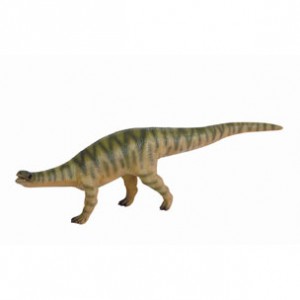Study of Microfossils shows Thecodontosaurus to be an Inhabitant of Island Paradise
Research into the microscopic fossils from sediments similar to those where fossils of the early Jurassic prosauropod Thecodontosaurus have been found reveal that scientists may have got it wrong when it comes to considering this dinosaurs habitat.
Thecodontosaurus
Previously, palaeontologists had thought that this small dinosaur had inhabited a dry, desert upland area but a study of palynomorphs (organic-walled microfossils such as plant spores and marine algae), show that lush, tropical islands were its home.
It had been thought the dinosaur lived in the arid uplands of the Late Triassic. However, a joint paper published by Dr David Whiteside (University of Bristol) and Professor John Marshall (University of Southampton), provides more information on the palaeoenvironment and shows that small islands were this little dinosaurs home.
Thecodontosaurus was approximately 2-3 metres long, although most its length was made up by its tail and neck. Its fossils have been found in the Bristol area of south-west England and also in Germany. It resembled Plateosaurus but was much smaller, perhaps as a result of living on islands. Dwarfism is a common feature of island animals as there are fewer resources for animals to exploit in the limited land area.
A Plateosaurus
Picture credit: Everything Dinosaur
The Plateosaurus pictured above shows the basic body plan of a Thecodontosaurus, but Plateosaurus was much larger, perhaps exceeding 8 metres in length.
There used to be a scale model of Plateosaurus available, designed by a German team (Bullyland museum line), however this model has now been retired.
To view the existing Museum Line range and other models: Dinosaur and Prehistoric Animal Models.
The first fossils of this dinosaur were discovered in 1834, this was actually before Sir Richard Owen had coined the word “Dinosauria” so for a few years scientists were unsure how to actually classify this animal. The debate as to its classification continues today, as some scientists argue that the very primitive features exhibited by Thecodontosaurus may indicate that it may actually be a representative of the sauropodomorph dinosaurs and not a prosauropod.
Numerous Specimens are Known
A number of specimens of this dinosaur are known, all are important as the global fossil record for vertebrates at the Triassic/Jurassic geological boundary is quite poor. Unfortunately, the holotype (the specimen upon which the original description of Thecodontosaurus is based), was destroyed in a German bombing raid over England in World War II.
Dr Whiteside and Professor Marshall combined their expertise in Late Triassic reptiles and microfossils to provide a much more detailed picture of the habitat of Thecodontosaurus. Their work is supported by geological studies of the Bristol area which indicates that during this dinosaurs time the area consisted of a shallow, tropical sea with small islands dotted around it.
The remains of what were once prominent limestone plateaux can be identified by geologists, tracing the rock strata around the Vale of Glamorgan. These higher areas would have been above sea level and form islands. This collaborative work between the two universities has helped produce a much more complete understanding of the ecosystem that Thecodontosaurus lived in.
Perhaps Thecodontosaurus could have swam between islands in search of food. Its long tail could act as a rudder and provide propulsion whilst its strong limbs would have made it quite a powerful swimmer. The neck, although not as long as with other prosauropod type dinosaurs such as Anchisaurus, could easily have been held out of the water as this animal paddled along.
“Socket-toothed Lizard”
Thecodontosaurus means “socket-toothed lizard” . The teeth are unusual for a dinosaur of this type, they were shaped a bit like a modern monitor lizards. Each tooth was embedded in a separate tooth socket and they were small, serrated and blade-like. Thecodontosaurus could represent an important evolutionary shift for the dinosaur clade, moving away from a carnivorous life-style and taking to a diet of plants. Could animals like Thecodontosaurus have heralded a change in dinosaur diets? Certainly, living on small islands with a limited food supply would have predisposed these animals towards a more varied diet, perhaps adapting to plants as these would have proved to be a more reliable food source.
Whatever the actual relationship between Thecodontosaurus and the other long-necked dinosaurs, their evolutionary journey seems to have been a pretty successful one. Sauropods survived to the very end of the Mesozoic and along the way they evolved into animals like Brachiosaurus, Diplodocus and Argentinosaurus – the largest land animals ever known.







Leave A Comment